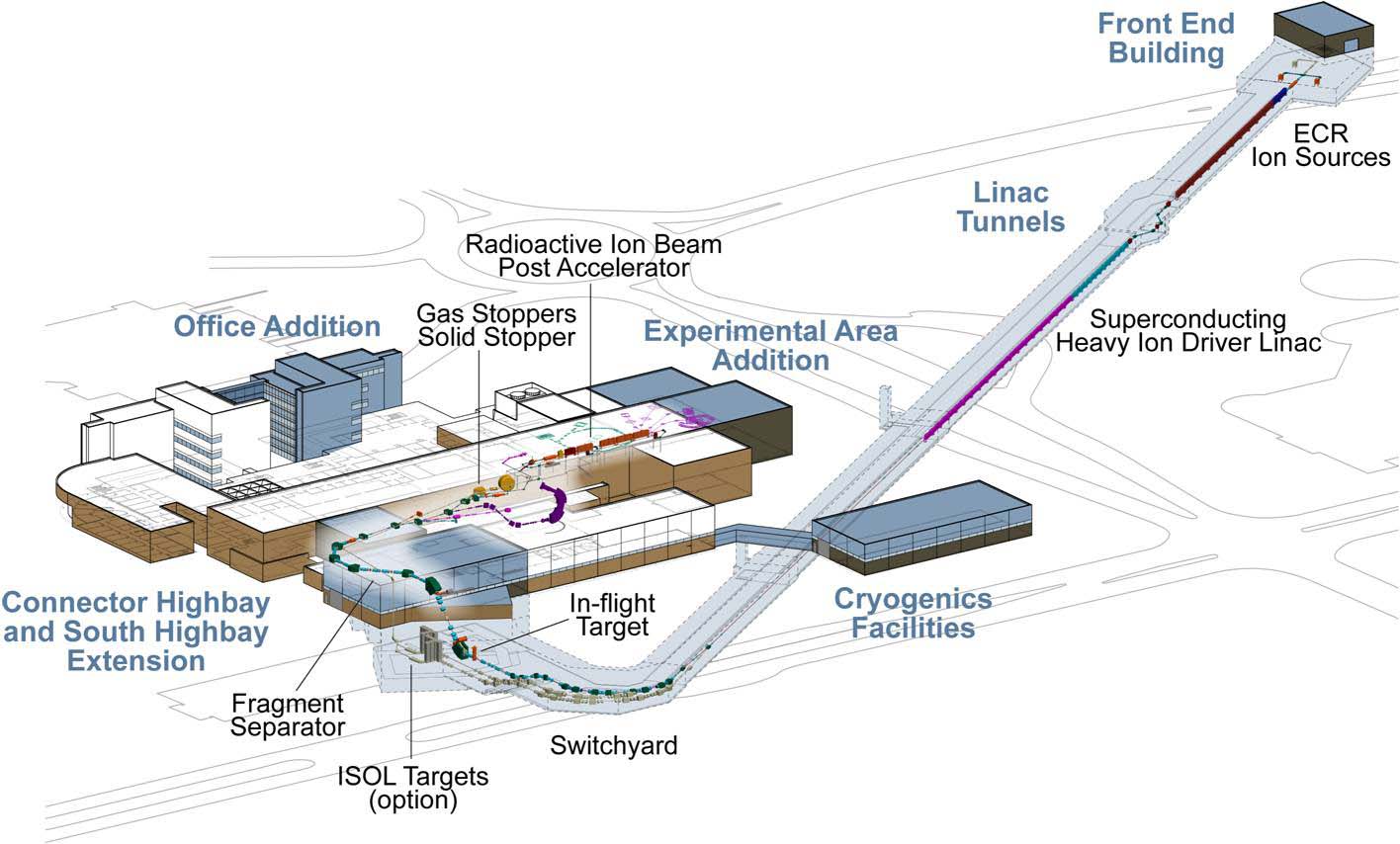Contact: Paul Preuss
In a scientific keynote address on Friday, June 12 at Michigan State University (MSU) in East Lansing, James Symons, Director of Berkeley Lab’s Nuclear Science Division (NSD), discussed the exciting research prospects of the new Facility for Rare Isotope Beams (FRIB) to be built at MSU’s National Superconducting Cyclotron Laboratory.
The U.S. Department of Energy’s new Under Secretary of Science Steve Koonin, himself trained as a nuclear physicist, delivered the keynote address at a luncheon following the ceremony. Famed physics rapper Liz McAlpine was one of the participants at the kickoff, along with officials from MSU, DOE, and the National Science Foundation (NSF).
FRIB is a $550 million heavy-ion accelerator to study rare nuclear processes, including the formation of elements heavier than hydrogen and helium in the hearts of stars and in violent cosmic events like the fearsome explosions of supernovae. To this end, FRIB will create intense beams of short-lived nuclei not normally found on earth; in addition to advances in basic science, studying these interactions is expected to yield applications in materials science and medicine.
The modern concept of a rare-isotope accelerator evolved at Berkeley Lab from the HILAC (heavy ion linear accelerator) built in the late 1950s, which in 1972 led to the SuperHILAC, capable of accelerating uranium ions. In 1989 the late Mike Nitschke of NSD proposed that DOE build a Rare Isotope Accelerator, which eventually became FRIB. Symons played a key role in its genesis while serving as leader of DOE’s and NSF’s Nuclear Science Advisory Committee. Besides ideas, Berkeley Lab has made major contributions to the FRIB concept in the form of two key components, the prototype for its principal ion source, and what will be its principal gamma-ray detector.
The prototype for the FRIB ion source is VENUS, a superconducting electron-cyclotron resonance (ECR) source which has the world’s most powerful magnetic confinement system for an ECR plasma. (VENUS stands for “versatile ECR ion source for nuclear science.”) Operating with high-frequency microwaves (28 gigahertz, or 28 billion cycles per second), VENUS holds records for beam intensity and heavy-ion charge states, and readily produces ions from hydrogen all the way up to U55+, uranium atoms stripped of more than half their electrons.
As atomic nuclei become more massive their ratio of neutrons to protons increases and they become unstable, tending to fall apart in seconds or less; unstable nuclei are not only rare but hard to produce. FRIB will collide an energetic beam of stable ions into targets to make separate beams of rare, short-lived isotopes, then study their properties during their brief existence and rapid demise.
Measuring the velocity and energy of emitted gamma rays is a principal means for studying just what happens to heavy nuclei as they spin and subsequently fall apart. A major advance in gamma-ray detectors will be among the detectors at FRIB’s experimental end, one pioneered and now being built at Berkeley Lab, called GRETA (Gamma Ray Energy Tracking Array). Presently under construction in its prototype form, GRETINA, GRETA is based on high-purity germanium crystals, a material that combines capture efficiency, high resolution, and the capacity to cleanly distinguish higher-energy from lower-energy gamma-ray events.
In the detector, each set of interlocking crystals is cooled by liquid nitrogen and arranged facing inward; there the crystal faces will eventually form an almost closed sphere surrounding the area where nuclei disintegrate under specific conditions. Although a gamma ray can bounce off an electron inside a crystal and keep on going right through it, GRETA will recover those lost signals through energy tracking. By summing the signals deposited by a single gamma ray in adjacent detectors, the full energy will be recovered.

The proposed configuration of FRIB at MSU’s National Superconducting Cyclotron Laboratory. (Click on image for best resolution.)
“In its final incarnation, GRETA will probably be the leading instrument for research at the new rare-isotope facility,” says Symons.
FRIB, funded by the Office of Nuclear Physics within DOE’s Office of Science, will be a National User Facility, providing research opportunities for the international community of nuclear scientists in universities, government agencies, and industry. The highest-priority research projects will be chosen from submitted proposals by an advisory committee of experts from universities and national laboratories convened by MSU.
Pending Congressional appropriations to support FRIB’s $550 million funding estimate, which does not include operations or research once the facility is completed, final design and construction are estimated to take 10 years.
Additional information
For more on FRIB, and to check out Liz McAlpine’s “Rare Isotope Rap,” visit http://www.symmetrymagazine.org/breaking/2009/06/15/rare-isotope-rap/
Still more information on FRIB is available at www.frib.msu.edu
More on the VENUS ion source is at http://www.lbl.gov/Science-Articles/Archive/sabl/2007/Feb/VENUS.html
More on GRETA and GRETINA is at http://www.lbl.gov/Science-Articles/Archive/sabl/2006/Mar/06-catching-rays.html
Visit the Nuclear Science Division website at http://www.lbl.gov/nsd/